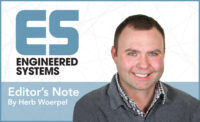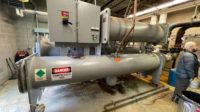The regulatory landscape for the HVAC industry is evolving, ushering in major changes for manufacturers. Several of these changes are driven by a goal of harmonizing global safety requirements. One of the biggest changes coming to the industry in the next five years is the transition to UL 60335-2-40, which will bring about more rigorous testing standards for HVAC appliances and equipment.
Currently there are several standards used in the HVAC industry: UL 1995, CSA C22.2 #236, UL 484, CSA C22.2 #117, UL 474, CSA C22.2 #92, and UL 60335-2-40/CSA C22.2 No. 60335-2-40. However, as of January 2024, UL 60335-2-40/CSA C22.2 No. 60335-2-40 will replace all of these standards, becoming the primary standard for HVAC equipment in North America. Products certified to previous standards will not be grandfathered to UL 60335-2-40, meaning both new and existing products will eventually need to be tested to the new standard.
It’s important for manufacturers to understand the new standard as well as their options for testing and certification during the transition period of the next five years. This is particularly true when transitioning from UL 1995 and CSA C22.2 No. 236, which currently act as the overarching harmonized standards for HVAC equipment in the U.S. and Canada.
UL 60335-2-40/CSA C22.2 No. 60335-2-40
Published in 2012 and revised in the fall of 2017, UL 60335-2-40 is based upon IEC 60335-2-40, fifth edition, and is harmonized with CAN/CSA-C22.2 NO. 60335-2-40 (Canada). It applies to packaged air conditioners and heat pumps, partial units, liquid chillers and hydronic fan coil units, hot water heat pumps, dehumidifiers, room air conditioners, and supplemental heaters and equipment with flammable refrigerants. The standard outlines multiple requirements for spacing, components, and flammable refrigerants. It must be used in conjunction with UL 60335-1/CSA C22.2 No. 60335-1, and there are more than 150 deviations to manage as engineers read through and determine the requirements within UL 60335-2-40 that are applicable to HVAC equipment.
UL 60335-2-40 is a test-based standard as opposed to a construction-based standard, like UL 1995. This, coupled with new component requirements, means that in most cases, existing equipment and components will require full evaluation and testing to the new requirements.
As previously mentioned, the new standard includes more rigorous testing requirements. UL 60335-2-40 also has a similar type test for each of the tests used in UL 1995 or UL 484, but the new standard goes beyond that; it has many tests that are unique compared to what has been done in the past for product certifications. The new protocols include numerous criteria, such as:
- Electronic Circuit Fault Test: Evaluates equipment that is otherwise running in normal operations with typcial faults performed in open and short circuits on electronic components. If a circuit is low-power (not exceeding 15 W) and is not a safety circuit, fault tests are not required. Additional tests, such as EMC and software evaluation, may be applicable for protective electronic controls (PEC).
- Loss of Charge Test: In appliances where the compressor is enclosed in a way that may be inadequately ventilated, a test must be conducted with 75% of the charge removed and the system pressure between 0.10 MPa and 0.12 MPa with the applicance de-energized. The tests must last at least 24 hours — longer if more time is needed to stabilize temperatures.
- Glow Wire Test: Conducted in accordance with IEC 60695-2-11 to test a material’s resistance to fire. All parts of non-metallic material must be evaluated at 550°C unless it: has a GWFI of at least 550°C; has a classification of at least HB40; is a soft or foamy material classified as HBF; has a mass less than 0.5g and (if cummulative employed) would not likely propogate flames; or is a decorative trim, knob, or other part unlikely to be ignited.
-
Non-Metallic Material Flammability in Proximity to Electrical Connections, Which Specifies:
- Flammability Characteristics: Evaluates each non-metallic material within 3 mm of an electrical connection or located within the envelope of a vertical flame cylinder having a diameter of 20 mm and height of 50 mm. Wire, tubing, and sleeving must have a rating of VW-1; tape must comply with CSA C22.2 No 197 and UL 510 for flame retardent insulating tape; other non-metallic materials must have a minimum V-0,VTM-0, SC-0, or SCTC-0; or, depending on their proximity to the electrical connection, be HF-1, have a GWIT of 775°C according to IEC 60695-2-13, or have a GWT according to IEC 60695-2-11 with a minimum test severity of 750°C with test flames that persist no longer than 2 seconds. In the event that the materials do not comply with the required flammability characteristics, the nichrome wire test is conducted.
- Nichrome Wire Test Requirements: Attempts to intentionally create a fire at the connection point within an appliance, using a nichrome wire energized at 11 amps for 20 minutes. If ignition does occur, cheesecloth wrapped around the product cannot have any thread breaks but can be browned. An appliance control or device to protect from fire risk can be used to de-energize the nichrom wire, but it must be evaluated as a protective control.
-
Additional Assessments Include Those for:
- Power input and current;
- Heating (cooling and heating operation tests);
- Abnormal temperature;
- Electric heating; and
- Ball pressure.
Future Expectations
It is expected that UL 60335-2-40 will continue to evolve, as it will soon broaden its requirements for appliances with flammable refrigerants when the third edition is published late in 2019. Major changes to the standard will likely include:
- Expansion of scope to completely cover (and ultimately replace) UL 1995, UL 484, and UL 474;
- Expansion of scope to include Class A2L flammable refrigerants and Class B1 refrigerants;
- Adoption of existing flammable refrigerant language within the standard, setting further compliance landscape for multi-split systems;
- Expansion of flammable refrigerants to appliances not considered factory-sealed (such as split systems) and increasing flammable refrigerant charge levels;
- Addition of UV-C requirements for appliances incorporating germicidal type lamps;
- Expansion of scope to include dehumidifiers without motor-compressors (desiccant type) and thermoelectric heat pumps; and
- Clarification of test parameters, such as leakage current, loss of refrigerant charge, locked rotor and transformer overload, and heat pump water heater testing.
Best Practices
With additional changes on the horizon and a standard that must be met in both new and existing products within five years, many manufacturers may be looking for guidance about their options for testing and certification during this transition period. Until the effective date in 2024, manufacturers may continue using UL 1995/CSA C22.2 No. 236 fourth edition to test and certify new equipment. This option allows the use of a standard more familiar to the industry, and current UL 1995 certification can be transferred to testing partners willing to continue to use this standard. In the interim, the new harmonized standard, 60335-2-40, can be used during the R&D phase, with the knowledge that new products will need to comply in five years. New and existing products can also begin to be tested and certified to the new standard as soon as manufacturers would like to pursue the testing.
When using the new standard, it’s important to work with teams and trusted partners who can assist with the transition while maintaining operations and product development. Stay well informed on the requirements of the standard and of future developments so that you can being to implement the necessary changes to meet them in time for the 2024 deadline. Be prepared for additional changes and updates during the transition period and consider these requirements from the inception of new product development. With forethought, education, and planning, manufacturers can achieve compliance to UL 60335-2-40 for future and current products, helping to ensure a smooth transition and product success in the U.S. and Canada.





